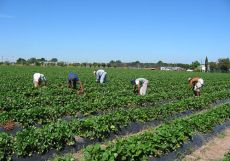Thursday, April 25, 2024
News and Views from the Global South
URUGUAY: Fighting Climate Change from the Countryside
Inés Acosta
- “We would get up and go to bed every day looking up at the sky, hoping for something to fall, but nothing happened, not even a drop fell,” says María Inés Queiros, who makes artisanal cheese in the southern Uruguayan province of San José.
Small-scale producers like her were hit hardest by the drought that devastated a large part of this South American country in the last quarter of 2008 and the first quarter of 2009.
The social and economic consequences of the severe drought are still being felt, as well as fears of a repeat. Rural associations estimate that farmers lost 868 million dollars in that period.
“I took it in stride, thank God. Others got sick, couldn’t handle the nerves and gave up. They left the countryside out of fear of that happening again,” Queiros adds.
Her determination to stay on her land no matter what helped Queiros, who has been working in the countryside since the age of 13, get through the rough time. “I had faith that it would pass, and I decided to fight it out; there was nothing else I could do,” she says
Agriculture, the engine of the Uruguayan economy, is highly vulnerable to climate change, which is causing greater weather variability and more extreme natural events like droughts and flooding, in a country otherwise free of catastrophes like hurricanes, earthquakes and tsunamis.
The idea was to develop an adaptation strategy to strengthen the sectors most exposed to the effects of drought and flooding and help farmers remain in the countryside.
Besides the “climate change response plan” that functions at a national level, a programme was designed to operate at a local level, with the aim of cutting greenhouse gas emissions and helping local areas adapt to climate change.
The programme, funded with 1.5 million dollars donated by various international bodies, is sponsored by the United Nations Development Programme (UNDP) and covers the metropolitan region, which includes the semi-rural and rural areas around the capital, Montevideo, as well as the neighbouring provinces of Canelones and San José.
“This initiative, which will serve as a pilot plan, constitutes the first concrete regional-level experience of analysis and application of climate change adaptation and mitigation measures,” Paul Moizo, head of the Agenda Metropolitana, through which the plan is implemented, explained to IPS.
Agenda Metropolitana emerged in 2005 from a political agreement between the governments of the provinces of Montevideo and Canelones, both of which are governed by the left-wing Broad Front coalition, and the government of San José, in the hands of the right-wing National Party, with the aim of taking a joint approach to agricultural and climate change-related problems.
These three provinces in the south of the country on the coast of the Rio de la Plata (River Plate) estuary are home to two-thirds of Uruguay’s 3.3 million people, and represent two-thirds of GDP.
They make up a heavily agricultural area, supplying fresh produce and dairy products to the city of Montevideo and for export. The area also includes a large part of the basin of the Santa Lucía river, which provides drinking water for 60 percent of the population of this small country wedged between Argentina and Brazil.
This area produces most of the country’s carbon dioxide emissions, the main greenhouse gas.
Ethel Badin, the director of environmental management in the provincial government of Canelones and the head of the project in that province, told IPS that one of the problems facing agriculture there, as a result of climate change, is scarcity of water at times of drought.
Others are the damages caused to crops by heavy rains, the vulnerability of natural areas due to unsustainable farming and ranching techniques, the increased risk of forest fires, an increase in pollution of water and soil, and worsening infestations of pests and diseases affecting crops and livestock.
Agriculture is the most vulnerable activity to climate change, said the director of the development unit at the San José city government, Mercedes Antía, who is also involved in the project.
“The metropolitan area concentrates a large number of small farmers, who are more exposed to climate change and are less able to deal with the phenomenon than large-scale producers,” she told IPS.
As a result of the last major drought, farmers began to sell off their cattle and lost capital, and rebuilding their herds has been a major challenge, Antía said.
“The social impact was severe. People suffered from cardiac and psychiatric problems, some families fell part, and many of the children who saw their parents suffer have questioned whether it’s worth staying on the farm,” she said.
“It was the anguish of losing everything in just a few months. People never imagined that a drought would affect them so heavily. In the face of that scenario, the project is looking at what can be done so the next time it happens, we won’t be caught off guard so badly.”
According to Moizo, the project will give an idea of the volume of greenhouse gases emitted by the provinces in question, provide a diagnosis of the sectors most vulnerable to climate change, and generate a series of concrete projects focused on resolving a range of problems.
The initiative was endorsed by the general assembly of the Network of Regional Governments for Sustainable Development, which met in October 2008 in St. Malo, France.
The Network’s third World Regions Summit on climate change, to be held Apr. 20-22 in Montevideo, will draw 450 representatives from around the world and has been chosen as a good opportunity to present the Uruguayan project.

 Print
Print




